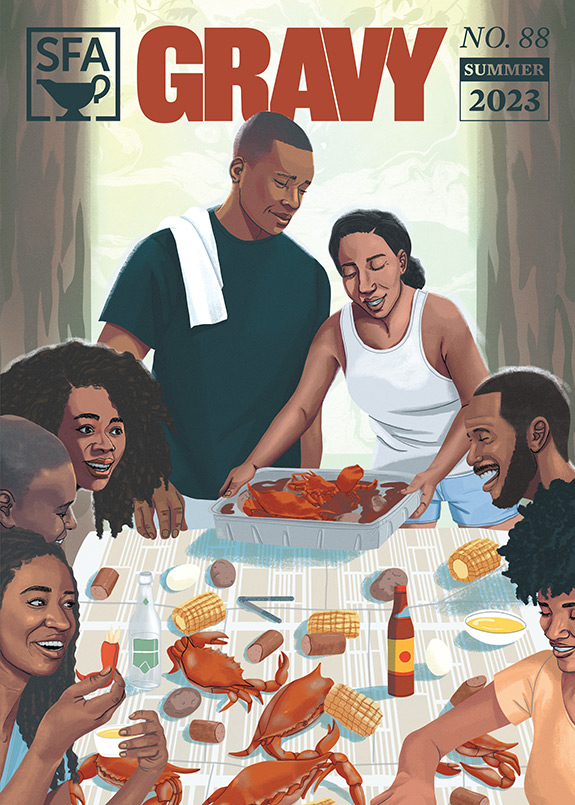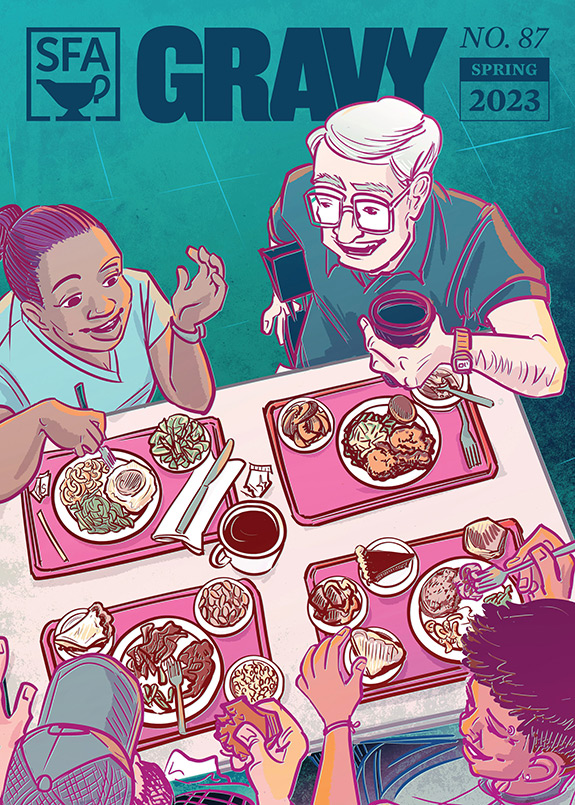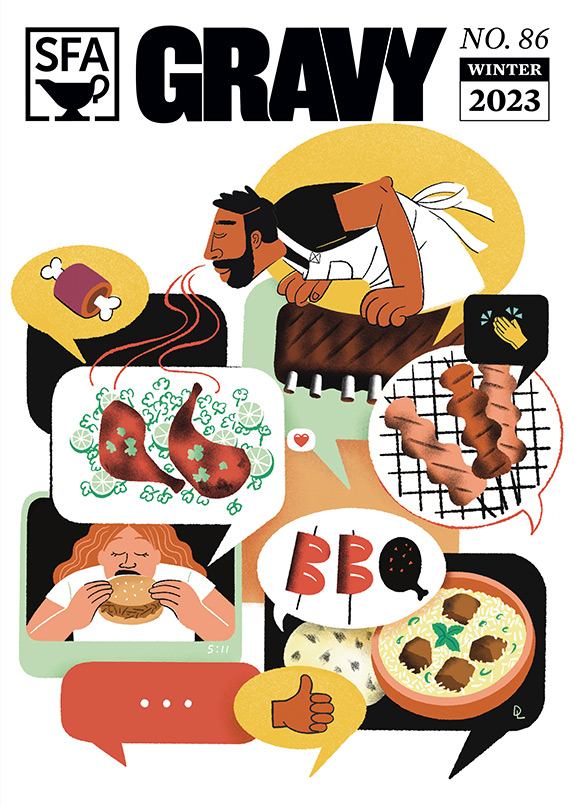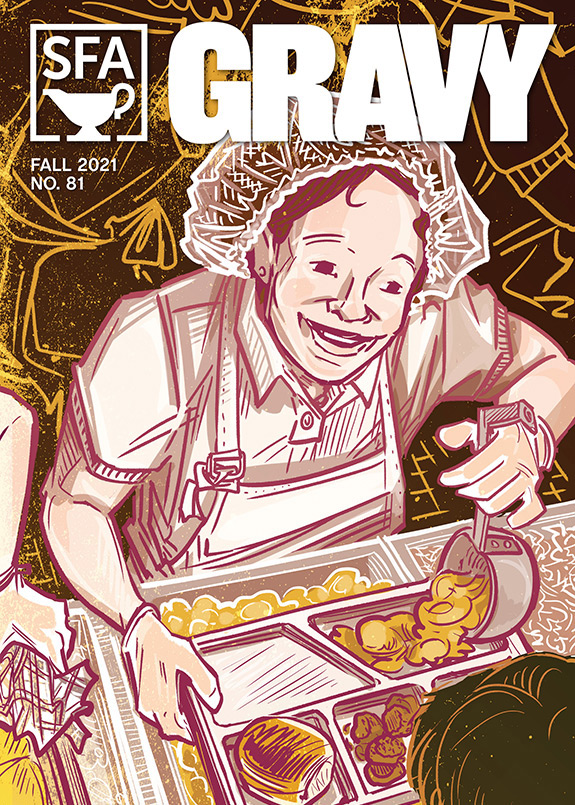This story first appeared in issue #57 (fall 2015) of our Gravy quarterly. The author, Katy Clune, is a recent graduate of the MA program in folklore at UNC-Chapel Hill.
Did you know that all SFA members receive a subscription to the print edition of Gravy? Join or renew your membership to get on the Gravy train.
Tasting Laos in the North Carolina Mountains
A gentle diplomacy of flavor
by Katy Clune
In the quiet of the early morning in Vientiane, steam rises from sticky rice. Women sit on low bamboo stools waiting for tak baht, the morning ritual of serving monks their daily meal. Wrapped in dark orange robes, young men cradling alms bowls walk single file. As they pass each group of morning worshippers, the men stop, turn to face away from the street, and chant in thanks.
While the warmth of the sun is still gentle, fishermen and -women wade into the Mekong, their longboats rigged with intricate homemade bamboo nets. Across the city, vendors sell fresh river fish: skewered, salted, and grilled; wrapped in banana leaves and steamed; or cooked at waterside tables in hot pots. Kitchens are typically outdoors, centered around a low wood- or coal-fired concrete brazier. As the day heats up, women move their vegetables and cutting blocks from inside to the breezy shade, transforming residential streets into ad-hoc prep areas. Their syncopated chatter and the beat of mortar and pestle mingle with the sounds of passing motorcycles. Trays of chilies and patties of day-old rice dry in the late-afternoon sun. The evening meal begins with a Beerlao poured over ice.

When I arrived in Vientiane, the Lao capital, the outdoor markets drew me in. I was overwhelmed by the abundance of fresh vegetables, fruits, and meats—a colorful reflection of the country’s agrarian economy. Under the tarp canopies was a sea of green, with flashes of silver (fish), red (chilies), purple (eggplant), and the orange of marigold-studded temple offerings. Shoppers coveted seasonal delicacies.
In early summer in Luang Prabang—the old royal seat in the north—there were round, earthy, dumpling-like mushrooms; jumping frogs; and a precious foraged ant nest resting on a banana leaf. There was an art to these market displays. Vendors arranged quilts of colorful vegetables and fruits, braided and bundled herbs, and hung jerky and fried rice snacks overhead. Wandering the stalls, I sampled leaves fragrant and foreign. I learned that these bitter herbs, which had no English name, helped balance the heat of chilies. And without chilies, Lao food isn’t Lao.

A year before my first visit to Laos, the Phapphayboun family of Morganton, North Carolina, schooled me on the importance of the chili via papaya salad, a national staple. There ar eat least seven different names for chili peppers in Lao. My friend Toon, the family’s second oldest daughter, explained to me, “Without spice, it is not papaya salad; it is just tossed vegetables. It’s good, but it’s not Lao.”
I love heat, but I was out of my league when I ate with the Phapphaybouns. While I sat in a state of joyful distress, Toon reached for another raw green chili to chew between bites of papaya salad and laab—a cold, herbed, minced-meat dish.
The two Phapphayboun homes in Morganton are equipped with kitchens fit for feasts. Toon’s grandmother taught her mother, Noubath, how to make pickled fish and sour pork. Both women were known as the very best cooks in their Vientiane neighborhood. Noubath passed this knowledge of traditional Lao methods to her daughters. As I grew to know Toon and her family, I spent hours at their tables eating sticky rice (khao neow) with spicy dips (jaeow), soups (gheng), grilled fish, and fermented pork sausages (som muu). I also worked my way through the menu at Asian Fusion Kitchen restaurant, where Daraphone “Dara” Phrakousonh, Toon’s younger sister, serves Lao specialties both fiery and mild.
The meals I ate in Morganton repeated themselves half a world away in Vientiane, which I visited in summer 2014 in pursuit of greater context for this family’s journey. As I walked those early-morning streets and markets, I grasped more fully all that the Phapphaybouns had left behind—and I understood how cooking, eating, and sharing Lao food in North Carolina is the most natural way to bring their country to life in the mountain South.
The family’s daily togetherness is a triumph over history and circumstance. It is the taste of Laos that enables the Phapphaybouns to nurture their connectedness to each other and to home. At the same time, they use its spicy, tangy, salty, and sweet flavors to share their story in Morganton and build bridges of understanding.

Toon was the first in her family to escape Vientiane for America. She left in 1980, when she was just 14 years old. In 1975, despite covert U.S. operations that had lasted from the Eisenhower Administration through to the Johnson years, the communist Pathet Lao party overthrew the last vestiges of the old royal government. Our country’s involvement in Laos is a tragic, little-known chapter of the Vietnam War. In an effort to stanch the spread of communism in Southeast Asia, the United States secretly enlisted approximately 30,000 Hmong—an ethnic minority in Laos—to fight against their countrymen. We also dropped more than 2 million tons of bombs on the country. An average of one bomber left base every eight minutes for nine years. Countless explosives still rest, sinister and silent, just below rice paddies and forest floors.
This history deeply affected Toon’s family. In 1974, her father, La Phapphayboun, was assassinated. The following year, the man who would become her stepfather, Khamsi Bounkhong Siluangkhot, was imprisoned in a reeducation camp. Toon escaped the new government’s strict regime under the cover of night. She risked her life on a leaky canoe and made it safely across the Mekong River into Thailand.
“We started in the early morning,” Toon recalled. “We were so thirsty, when we crossed a sugarcane field we broke it and chewed it to get some juice and water in our body. We walked on mud along the rice paddies. All that horror stuff you read in books, I went through that.”
After eight months in refugee camps, Toon arrived in Los Angeles. She helped each member of her family make the journey to America. Twenty-three years later, the Phapphaybouns are reunited in Morganton, where the foothills of the Blue Ridge Mountains now evoke the mountains of Laos.

Seventeen thousand people live in Morganton, 60 miles northeast of Asheville. As you exit I-40, fast-food restaurants line the road. Zaxby’s, McDonald’s, and a drive-through sushi joint in a refurbished Burger King give way to a small downtown. Commissioned as the Burke County seat in 1784, Morganton first prospered as a railroad stop before lumber operations, furniture factories, and textile mills moved in. These industries require immigrant labor earlier than other parts of the South. French-speaking Waldesians came from Italy in the early 20th century. The region’s most recent wave of immigrants—indigenous Maya from Guatemala—began arriving in the 1980s. Between these two movements, Hmong refugees from Laos, displaced by the Vietnam War, began to settle in Morganton in the mid-1970s.
North Carolina’s Asian American population is growing quickly. Like other parts of the South, the state is a second migration site for immigrants who initially settled elsewhere. For Southeast Asians especially, the climate, landscape, and even the quiet of the countryside recall distant homes. Hmong greatly outnumber the Buddhist Lao in this part of the state. The Phapphaybouns are one of approximately 40 families in their community.
Dara and her husband, Danil, were the first in the Phapphayboun family to move to the South. The young couple eloped, rented an apartment, and began work in a textile factory in neighboring Valdese in 1994. Dara dreamed of opening her own business, hoping to bring the family together. In 2010, she opened Lao Lanxang Grocery (named for Laos’s ancient monarchy), and she soon began selling out of her Thursday-night pho and the sweet and salty snacks made by her mother, Noubath. On Valentine’s Day 2013, Dara opened a sit-down restaurant and a second iteration of her grocery store at a new location. She still works 12 hours a day, six days a week at Asian Fusion Kitchen.
Lao textiles and carvings decorate Asian Fusion Kitchen’s yellow walls, and framed photos of monuments in Vientiane hang just below the ceiling. Dara says she wanted “to show everybody where I come from, who I am, and why I do what I do, because I wanted to introduce everyone to Laos. Because everybody says, ‘Hey, you Chinese.’ Laos never exists! That’s why I said, ‘I’m going to open a restaurant or grocery store one day and I’m going to tell them I’m not Chinese, I am Lao.‘”
This love of country suffuses the Phapphaybouns’ palate. When I talked with Toon during our visit to Laos, she was bubbling with affection for the foods of her youth. It had been over 20 years since she was last in Vientiane. “I noticed a difference between the aroma of the lemongrass in America and the aroma of the lemongrass in Laos,” she said. “I could eat it plain, it’s so tasty here. There’s that aroma, there’s that crunch, that little hint of sweetness, lemon, and a kind of herby smell.” Grown and eaten at home, even an undressed herb is sublime. Sitting in her late father’s Vientiane home in the cool, dark air, Toon said, “I missed Laos the day I landed in Laos.” She acknowledged the impossibility of staying and the ever-present, bittersweet connection to her country—present in its flavors, however paled, in North Carolina.

Asian Fusion Kitchen is more than a place for the Lao community to gather around familiar foods. It is also the key way locals can learn from and engage with their new neighbors. While the essentials are in place—sticky rice served in thip kao (lidded bamboo baskets), papaya salad, and chilies—compromise and accommodation are at the heart of Dara’s restaurant.
She chose the name Asian Fusion Kitchen because it didn’t sound too spicy, and because some of her dishes “throw America and Asia together a little bit.” Lao and Hmong know to order laab or khao poon noodles off-menu. Through a gentle diplomacy of flavor, Dara is slowly introducing Morganton to her native cuisine. The restaurant is a success: She has expanded tables into her grocery store. Sticky rice is one of the most popular dishes. Dara loves it when her customers call it by its Lao name, khao neow.
Pam Roths, a native of Morganton, believes Dara and her family’s hospitality has a lot to do with her success in this small town. Pam likes to say that, on her first visit to Asian Fusion Kitchen, she “came looking for pho and found family.”
The rest of Morganton is catching on. Local craft brewery Fonta Flora created a special brew inspired by the Beerlao that Dara stocks. Brewed with turmeric, Charleston Gold rice, and miso, they call it Year of the Wood Goat.
Dara and her family bring Laos to the American South by balancing traditional foods with the palates of their customers. This spirit of accommodation makes Asian Fusion Kitchen an essentially Lao restaurant. “The Lao way is to be humble,” says Toon. “We do not force anything down anyone’s throat, and yet we accomplish what we want done. There are two ways: You can force the horse to water, but it won’t drink. The Lao way is to show you how to get to the river, and if you want to drink the water, that is fine—but you have found your own way there.”
For North Carolinians, the taste of Laos may not be as exotic as they think. Noubath ferments her Lao-style fish sauce, padaek, with fish from the nearby Catawba River and Lake James, and Dara occasionally uses it in her dishes at Asian Fusion Kitchen.
As communities like Morganton evolve, cultural exchange becomes an everyday occurrence. Families like the Phapphaybouns are paving the way. In April 2015, I joined in the celebration of Pii Mai, Lao New Year, at Wat Lao Sayaphoum. Toon’s parents helped establish this Buddhist temple in a double-wide trailer and carport thirteen miles outside of Morganton. As in Laos, on this festival day blue tarps were stretched above homemade snacks, mortars and pestles, and steaming bowls of noodles.
As I ate pho with the Phapphaybouns, I noticed two older white men gamely asking their Lao friends what foods were for sale, and joking at their inability to use chopsticks. I introduced myself to them and learned both men were Vietnam veterans, here on the invitation of new neighbors and coworkers. On a foggy morning in North Carolina, some 40 years after the conflict that displaced Toon’s family and so many others, food offered all a common ground.
Hungry for more? Visit Katy Clune’s website, Making Laos: Home in a New Place. And stay tuned for a Gravy podcast on North Carolina’s Laotian community, airing on February 11.









